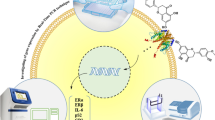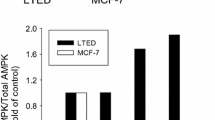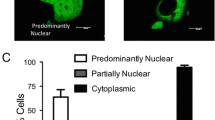Abstract
Hepatocellular carcinoma (HCC), the major manifestation of primary liver cancer, is one of the most frequent and malignant cancers worldwide, especially in Taiwan. Estrogen receptors (ERs) have been reported to play either a proliferation- or apoptosis-enhancing role in the differentiation of cancers, including HCC. In a previous experiment, we showed that transient overexpressed estrogen receptor-α induced early stage HCC cell line Hep 3B cell apoptosis by increasing the hTNF-α gene expression in a ligand-independent manner. To further clarify if the apoptotic effect occurs in poorly differentiated HCC cell line, HA22T, and elucidate the roles of ERs and TNF-α, DNA fragmentation and caspase activity were measured in late stage HCC cell line, HA22T, by measuring the expression of hER-α and hER-β using a Tetracycline-induciable system (Tet-on). Increased DNA fragmentation and caspase-3 activity were found in hERβ-overexpressed HA22T cells treated with estrogen (10−8 M) but not in hERα-overexpressed HA22T cells. Using RT-PCR/PCR and western blotting in HA22T cells, overexpressed hER-β was also found to increase the expression of hTNF-α mRNA and induce hTNF-α-dependent luciferase activity in a ligand-dependent manner. Additionally, LPS treatment and hER-β overexpression both enhance caspase-8 activities, whereas neither hER-β nor E2 treatment affected caspase-9 activities. In addition, the overexpressed hER-β plus E2 enhanced DNA fragmentation and caspase-8 activities were only partially reduced by anti-hTNF-α (0.1ng/ml), which was possibly due to the involvement of P53 and TGF-β. Taken together, our data indicates that overexpressed hER-β but not hER-α may induce caspase-8-mediated apoptosis by increasing the hTNF-α gene expression in a ligand-dependent manner in poorly differentiated HA22T cells. (Mol Cell Biochem xxx: 1–9, 2005)
Similar content being viewed by others
References
1. Pisani P, Parkin DM, Bray F, Ferlay J: Estimates of the worldwide mortality from 25 cancers in 1990. Int J Cancer 83: 18–29, 1999
Hall JM, Couse JF, Korach KS: The multifaceted mechanisms of estradiol and estrogen receptor signaling. J Biol Chem 276: 36869–36872, 2001
3. Moggs JG, Orphanides G: Estrogen receptors: orchestrators of pleiotropic cellular responses. EMBO Rep 2: 775–781, 2001
4. Grasso P: Malnutrition, liver damage, and cancer. Nutr Cancer 3: 103–108, 1981
5. Green S, Walter P, Kumar V, Krust A, Bornert JM, Argos P, Chambon P: Human oestrogen receptor cDNA: sequence, expression and homology to v-erb-A. Nature 320: 134–139, 1986
6. Enmark E, Pelto-Huikko M, Grandien K, Lagercrantz S, Lagercrantz J, Fried G, Nordenskjold M, Gustafsson JA: Human estrogen receptor beta-gene structure, chromosomal localization, and expression pattern. J Clin Endocrinol Metab 82: 4258–4265, 1997
7. Giguere V, Tremblay A, Tremblay GB: Estrogen receptor beta: re-evaluation of estrogen and antiestrogen signaling. Steroids 63: 335–339, 1998
8. Saunders PT: Oestrogen receptor beta (ER beta). Rev Reprod 3: 164–171, 1998
9. Byers M, Kuiper GG, Gustafsson JA, Park-Sarge OK: Estrogen receptor-beta mRNA expression in rat ovary: down-regulation by gonadotropins. Mol Endocrinol 11: 172–182, 1997
10. Kuiper GG, Carlsson B, Grandien K, Enmark E, Haggblad J, Nilsson S, Gustafsson JA: Comparison of the ligand binding specificity and transcript tissue distribution of estrogen receptors alpha and beta. Endocrinology 138: 863–870, 1997
11. Tremblay GB, Tremblay A, Copeland NG, Gilbert DJ, Jenkins NA, Labrie F, Giguere V: Cloning, chromosomal localization, and functional analysis of the murine estrogen receptor beta. Mol Endocrinol 11: 353–365, 1997
12. Hayashi S, Yoshida T: Regulation of ER(estrogen receptor) gene expression in the genesis and development of breast cancer. Nippon Rinsho 58: 495–503, 2000
13. Palmieri C, Cheng GJ, Saji S, Zelada-Hedman M, Warri A, Weihua Z, Van Noorden S, Wahlstrom T, Coombes RC, Warner M, Gustafsson JA: Estrogen receptor beta in breast cancer. Endocr Relat Cancer 9: 1–13, 2002
14. Paruthiyil S, Parmar H, Kerekatte V, Cunha GR, Firestone GL, Leitman DC: Estrogen receptor beta inhibits human breast cancer cell proliferation and tumor formation by causing a G2 cell cycle arrest. Cancer Res 64: 423–428, 2004
15. Ito T, Tachibana M, Yamamoto S, Nakashima J, Murai M: Expression of estrogen receptor (ER-alpha and ER-beta) mRNA in human prostate cancer. Eur Urol 40: 557–563, 2001
16. Signoretti S, Loda M: Estrogen receptor beta in prostate cancer: brake pedal or accelerator? Am J Pathol. 159: 13–16, 2001
17. Campbell-Thompson M, Lynch IJ, Bhardwaj B: Expression of estrogen receptor (ER) subtypes and ERbeta isoforms in colon cancer. Cancer Res 61: 632–640, 2001
18. Konstantinopoulos PA, Kominea A, Vandoros G, Sykiotis GP, Andricopoulos P, Varakis I, Sotiropoulou-Bonikou G, Papavassiliou AG: Oestrogen receptor beta (ERbeta) is abundantly expressed in normal colonic mucosa, but declines in colon adenocarcinoma paralleling the tumour's dedifferentiation. Eur J Cancer 39: 1251–1258, 2003
19. Spyridopoulos I, Sullivan AB, Kearney M, Isner JM, Losordo DW: Estrogen-receptor-mediated inhibition of human endothelial cell apoptosis. Estradiol as a survival factor. Circulation 95: 1505–1514, 1997
20. Delbes G, Levacher C, Pairault C, Racine C, Duquenne C, Krust A, Habert R: Estrogen receptor beta-mediated inhibition of male germ cell line development in mice by endogenous estrogens during perinatal life. Endocrinology 145: 3395–3403, 2004
21. Imamov O, Morani A, Shim GJ, Omoto Y, Thulin-Andersson C, Warner M, Gustafsson JA: Estrogen receptor beta regulates epithelial cellular differentiation in the mouse ventral prostate. Proc Natl Acad Sci U S A 101: 9375–9380, 2004
22. Nagasue N, Kohno H, Chang YC, Yamanoi A, Nakamura T, Yukaya H, Hayashi T: Clinicopathologic comparisons between estrogen receptor-positive and -negative hepatocellular carcinomas. Ann Surg. 212: 150–154, 1990
23. Villa E, Camellini L, Dugani A, Zucchi F, Grottola A, Merighi A, Buttafoco P, Losi L, Manenti F: Variant estrogen receptor messenger RNA species detected in human primary hepatocellular carcinoma. Cancer Res 55: 498–500, 1995
24. Ren Z, Yang B, Ye S: Estrogen receptor expression and its relationship with biologic feature in hepatocellular carcinoma. Zhonghua Zhong Liu Za Zhi 19: 10–13, 1997
25. Villa E, Colantoni A, Camma C, Grottola A, Buttafoco P, Gelmini R, Ferretti I, Manenti F: Estrogen receptor classification for hepatocellular carcinoma: comparison with clinical staging systems. J Clin Oncol 21: 441–446, 2003
26. Falcioni R, Kennel SJ, Giacomini P, Zupi G, Sacchi A: Expression of tumor antigen correlated with metastatic potential of Lewis lung carcinoma and B16 melanoma clones in mice. Cancer Res 46: 5772–5778, 1986
27. Lottich SC, Johnston WW, Szpak CA, Delong ER, Thor A, Schlom J: Tumor-associated antigen TAG-72: correlation of expression in primary and metastatic breast carcinoma lesions. Breast Cancer Res Treat 6: 49–56, 1985
28. Moon WS, Chang K, Tarnawski AS: Overexpression of metastatic tumor antigen 1 in hepatocellular carcinoma: Relationship to vascular invasion and estrogen receptor-alpha. Hum Pathol 35: 424–429, 2004
29. Takemura H, Kwan CY, Ohshika H: Calcium antagonistic actions of tetrandrine depend on cell types. Res Commun Mol Pathol Pharmacol 90: 59–68, 1995
30. Li J, Zheng R, Wang Z: Mechanisms of the induction of apoptosis in human hepatoma cells by tumour necrosis factor-alpha. Cell Biol Int 25: 1213–1219, 2001
31. Shima Y, Nakao K, Nakashima T, Kawakami A, Nakata K, Hamasaki K, Kato Y, Eguchi K, Ishii N: Activation of caspase-8 in transforming growth factor-beta-induced apoptosis of human hepatoma cells. Hepatology 30: 1215–1222, 1999
32. Hui R, Cornish AL, McClelland RA, Robertson JF, Blamey RW, Musgrove EA, Nicholson RI, Sutherland RL: Cyclin D1 and estrogen receptor messenger RNA levels are positively correlated in primary breast cancer. Clin Cancer Res 2: 923–928, 1996
33. Lamb J, Ladha MH, McMahon C, Sutherland RL, Ewen ME: Regulation of the functional interaction between cyclin D1 and the estrogen receptor. Mol Cell Biol 20: 8667–8675, 2000
34. Balasenthil S, Barnes CJ, Rayala SK, Kumar R: Estrogen receptor activation at serine 305 is sufficient to upregulate cyclin D1 in breast cancer cells. FEBS Lett 567: 243–247, 2004
35. Vater CA, Bartle LM, Dionne CA, Littlewood TD, Goldmacher VS: Induction of apoptosis by tamoxifen-activation of a p53-estrogen receptor fusion protein expressed in E1A and T24 H-ras transformed p53-/- mouse embryo fibroblasts. Oncogene 13: 739–748, 1996
36. Kim HS, Ingermann AR, Tsubaki J, Twigg SM, Walker GE, Oh Y: Insulin-like growth factor-binding protein 3 induces caspase-dependent apoptosis through a death receptor-mediated pathway in MCF-7 human breast cancer cells. Cancer Res 64: 2229–2237, 2004
37. Bush JA, Cheung KJ, Jr, Li G: Curcumin induces apoptosis in human melanoma cells through a Fas receptor/caspase-8 pathway independent of p53. Exp Cell Res 271: 305–314, 2001
38. Nicholson DW, Thornberry NA: Caspases: killer proteases. Trends Biochem Sci 22: 299–306, 1997
39. Li P, Nijhawan D, Wang X: Mitochondrial activation of apoptosis. Cell 116: S57–59, 52 p following S59, 2004
40. Ainbinder E, Revach M, Wolstein O, Moshonov S, Diamant N, Dikstein R: Mechanism of rapid transcriptional induction of tumor necrosis factor alpha-responsive genes by NF-kappaB. Mol Cell Biol 22: 6354–6362, 2002
41. Katzenellenbogen BS, Montano MM, Ediger TR, Sun J, Ekena K, Lazennec G, Martini PG, McInerney EM, Delage-Mourroux R, Weis K, Katzenellenbogen JA: Estrogen receptors: selective ligands, partners, and distinctive pharmacology. Recent Prog Horm Res 55: 163–193; discussion 194–165, 2000
42. Bezwoda WR, Meyer K: Effect of alpha-interferon, 17 beta-estradiol, and tamoxifen on estrogen receptor concentration and cell cycle kinetics of MCF 7 cells. Cancer Res 50: 5387–5391, 1990
Author information
Authors and Affiliations
Corresponding author
Additional information
Shares equally contribution Contract grant sponsor: National Science Council; Contract grant number: NSC 91-2314-B-075A-006, NSC 92-2314-B-075A-014.
Rights and permissions
About this article
Cite this article
Huang, EJ., Wu, CC., Lee, SD. et al. Opposing Action of Estrogen Receptors α and β on Tumor Necrosis Factor-α Gene Expression and Caspase-8-mediated Apoptotic Effects in HA22T Cells. Mol Cell Biochem 287, 137–145 (2006). https://doi.org/10.1007/s11010-005-9092-4
Received:
Accepted:
Published:
Issue Date:
DOI: https://doi.org/10.1007/s11010-005-9092-4




